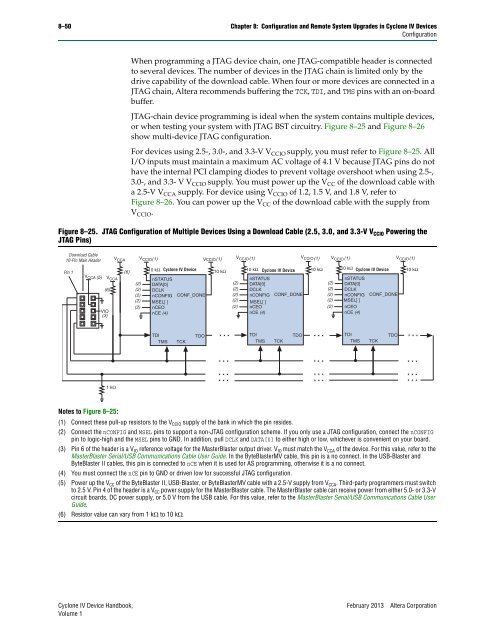Configuration and Remote System Upgrades in Cyclone IV ... - Altera
Configuration and Remote System Upgrades in Cyclone IV ... - Altera
Configuration and Remote System Upgrades in Cyclone IV ... - Altera
You also want an ePaper? Increase the reach of your titles
YUMPU automatically turns print PDFs into web optimized ePapers that Google loves.
8–50 Chapter 8: <strong>Configuration</strong> <strong>and</strong> <strong>Remote</strong> <strong>System</strong> <strong>Upgrades</strong> <strong>in</strong> <strong>Cyclone</strong> <strong>IV</strong> Devices<br />
<strong>Configuration</strong><br />
When programm<strong>in</strong>g a JTAG device cha<strong>in</strong>, one JTAG-compatible header is connected<br />
to several devices. The number of devices <strong>in</strong> the JTAG cha<strong>in</strong> is limited only by the<br />
drive capability of the download cable. When four or more devices are connected <strong>in</strong> a<br />
JTAG cha<strong>in</strong>, <strong>Altera</strong> recommends buffer<strong>in</strong>g the TCK, TDI, <strong>and</strong> TMS p<strong>in</strong>s with an on-board<br />
buffer.<br />
JTAG-cha<strong>in</strong> device programm<strong>in</strong>g is ideal when the system conta<strong>in</strong>s multiple devices,<br />
or when test<strong>in</strong>g your system with JTAG BST circuitry. Figure 8–25 <strong>and</strong> Figure 8–26<br />
show multi-device JTAG configuration.<br />
For devices us<strong>in</strong>g 2.5-, 3.0-, <strong>and</strong> 3.3-V V CCIO supply, you must refer to Figure 8–25. All<br />
I/O <strong>in</strong>puts must ma<strong>in</strong>ta<strong>in</strong> a maximum AC voltage of 4.1 V because JTAG p<strong>in</strong>s do not<br />
have the <strong>in</strong>ternal PCI clamp<strong>in</strong>g diodes to prevent voltage overshoot when us<strong>in</strong>g 2.5-,<br />
3.0-, <strong>and</strong> 3.3- V V CCIO supply. You must power up the V CC of the download cable with<br />
a 2.5-V V CCA supply. For device us<strong>in</strong>g V CCIO of 1.2, 1.5 V, <strong>and</strong> 1.8 V, refer to<br />
Figure 8–26. You can power up the V CC of the download cable with the supply from<br />
V CCIO.<br />
Figure 8–25. JTAG <strong>Configuration</strong> of Multiple Devices Us<strong>in</strong>g a Download Cable (2.5, 3.0, <strong>and</strong> 3.3-V V CCIO Power<strong>in</strong>g the<br />
JTAG P<strong>in</strong>s)<br />
Download Cable<br />
10-P<strong>in</strong> Male Header<br />
P<strong>in</strong> 1<br />
VCCA (5) VCCA (6)<br />
VIO<br />
(3)<br />
1 kΩ<br />
Notes to Figure 8–25:<br />
V CCA<br />
(6)<br />
VCCIO(1)<br />
VCCIO(1)<br />
nSTATUS<br />
(2) DATA[0]<br />
(2) DCLK<br />
(2) nCONFIG CONF_DONE<br />
(2) MSEL[ ]<br />
(2) nCEO<br />
nCE (4)<br />
TDI TDO<br />
TMS TCK<br />
VCCIO(1) nSTATUS<br />
(2) DATA[0]<br />
(2) DCLK<br />
(2) nCONFIG CONF_DONE<br />
(2) MSEL[ ]<br />
(2) nCEO<br />
nCE (4)<br />
TDI TDO<br />
TMS TCK<br />
VCCIO(1) VCCIO(1) VCCIO(1) 10 kΩ <strong>Cyclone</strong> <strong>IV</strong> Device<br />
10 kΩ<br />
10 kΩ <strong>Cyclone</strong> <strong>IV</strong> Device 10 kΩ 10 kΩ <strong>Cyclone</strong> <strong>IV</strong> Device 10 kΩ<br />
nSTATUS<br />
(2) DATA[0]<br />
(2) DCLK<br />
(2) nCONFIG CONF_DONE<br />
(2) MSEL[ ]<br />
(2) nCEO<br />
nCE (4)<br />
TDI TDO<br />
TMS TCK<br />
(1) Connect these pull-up resistors to the VCCIO supply of the bank <strong>in</strong> which the p<strong>in</strong> resides.<br />
(2) Connect the nCONFIG <strong>and</strong> MSEL p<strong>in</strong>s to support a non-JTAG configuration scheme. If you only use a JTAG configuration, connect the nCONFIG<br />
p<strong>in</strong> to logic-high <strong>and</strong> the MSEL p<strong>in</strong>s to GND. In addition, pull DCLK <strong>and</strong> DATA[0] to either high or low, whichever is convenient on your board.<br />
(3) P<strong>in</strong> 6 of the header is a VIO reference voltage for the MasterBlaster output driver. VIO must match the VCCA of the device. For this value, refer to the<br />
MasterBlaster Serial/USB Communications Cable User Guide. In the ByteBlasterMV cable, this p<strong>in</strong> is a no connect. In the USB-Blaster <strong>and</strong><br />
ByteBlaster II cables, this p<strong>in</strong> is connected to nCE when it is used for AS programm<strong>in</strong>g, otherwise it is a no connect.<br />
(4) You must connect the nCE p<strong>in</strong> to GND or driven low for successful JTAG configuration.<br />
(5) Power up the VCC of the ByteBlaster II, USB-Blaster, or ByteBlasterMV cable with a 2.5-V supply from VCCA. Third-party programmers must switch<br />
to 2.5 V. P<strong>in</strong> 4 of the header is a VCC power supply for the MasterBlaster cable. The MasterBlaster cable can receive power from either 5.0- or 3.3-V<br />
circuit boards, DC power supply, or 5.0 V from the USB cable. For this value, refer to the MasterBlaster Serial/USB Communications Cable User<br />
Guide.<br />
(6) Resistor value can vary from 1 k to 10 k.<br />
<strong>Cyclone</strong> <strong>IV</strong> Device H<strong>and</strong>book, February 2013 <strong>Altera</strong> Corporation<br />
Volume 1
















